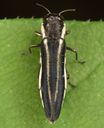Agrilus
Agrilus
Classification
- Phylum: Arthropoda
- Subphylum: Hexapoda
- Class: Insecta
- Order: Coleoptera
- Suborder: Polyphaga
- Superfamily: Buprestoidea
- Family: Buprestidae
- Subfamily: Agrilinae
- Tribe: Agrilini
- Genus: Agrilus
Pronunciation
How to pronounce Agrilus: /ˈæɡrɪləs/
These audio files are automatically generated. While they are not always 100% accurate, they are a good starting point.
Images






Summary
The emerald ash borer (Agrilus planipennis) is an invasive beetle native to northeastern Asia that primarily infests and damages ash trees (Fraxinus spp.).
Physical Characteristics
Adult beetles are typically bright metallic green, approximately 8.5 mm long and 1.6 mm wide. Elytra are usually darker green, sometimes with copper hues. The only North American species of Agrilus with a bright red upper abdomen when viewed with the wings and elytra spread. Features include a small spine at the tip of the abdomen and serrate antennae beginning at the fourth segment. Larvae create long serpentine galleries beneath the bark and have a fully mature length of 26 to 32 mm.
Identification Tips
Look for bright metallic green color, size (around 8.5 mm long), serrate antennae beginning at the fourth segment, and a characteristic D-shaped exit hole in infested trees. The unique bright red upper abdomen of adults when viewed wings spread is a key identification feature.
Habitat
Native to temperate forests in northeastern Asia where ash trees are present. Invasive in various environments in North America, particularly in areas with significant ash populations.
Distribution
Native to Russia, Mongolia, northern China, Japan, and Korea. Invasive and highly destructive in North America, with populations primarily in Michigan and surrounding areas, and spreading to other states and parts of Canada.
Diet
Larvae feed on the inner bark, phloem, cambium, and outer xylem of ash trees, disrupting nutrient flow, while adults primarily feed on the leaves of ash trees.
Life Cycle
The life cycle can take one to two years depending on environmental factors. After mating, females lay eggs in bark crevices, which hatch into larvae that feed and create serpentine galleries. Larvae pupate in fall and emerge in late spring.
Reproduction
Females lay approximately 40–70 eggs, occasionally up to 200, in bark crevices. Mating lasts about 50 minutes, and females can mate with multiple males.
Predators
Native woodpeckers, though their impact on emerald ash borer populations is variable. Some parasitoid wasps may also prey on larvae.
Ecosystem Role
As an invasive species, emerald ash borer disrupts local ecosystems by killing ash trees, which alters habitat and food sources for many species, affecting the biodiversity of forest ecosystems.
Economic Impact
Significant economic burden due to the costs associated with managing ash tree populations and the loss of ash trees in urban and rural areas. The estimated cost of management and replacement can reach up to billions of dollars.
Collecting Methods
- Visual surveys of damaged trees
- Traps (e.g., purple traps)
- Girdled trees to attract females for monitoring
Preservation Methods
- Insecticides (e.g., imidacloprid, dinotefuran)
- Biological control with parasitoid wasps
- Proper disposal of infested materials
Misconceptions
Emerald ash borer is often confused with other beetle species due to similar physical characteristics. Public misidentification is common.
Tags
- emerald ash borer
- invasive species
- wood borer
- ash trees
- buprestidae